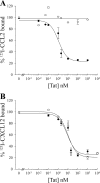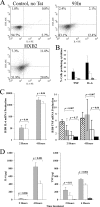Human immunodeficiency virus type 1 subtype C Tat fails to induce intracellular calcium flux and induces reduced tumor necrosis factor production from monocytes
- PMID: 17376903
- PMCID: PMC1900281
- DOI: 10.1128/JVI.01938-06
Human immunodeficiency virus type 1 subtype C Tat fails to induce intracellular calcium flux and induces reduced tumor necrosis factor production from monocytes
Abstract
Over 50% of all human immunodeficiency virus type 1 (HIV-1) infections worldwide are caused by subtype C strains, yet most research to date focuses on subtype B, the subtype most commonly found in North America and Europe. The HIV-1 trans-acting regulatory protein (Tat) is essential for regulating productive replication of HIV-1. Tat is secreted by HIV-infected cells and alters several functions of uninfected bystander cells. One such function is that, by acting at the cell membrane, subtype B Tat stimulates the production of tumor necrosis factor (TNF) and chemokine (C-C motif) ligand 2 (CCL2) from human monocytes and can act as a chemoattractant. In this study, we show that the mutation of a cysteine to a serine at residue 31 of Tat commonly found in subtype C variants significantly inhibits the abilities of the protein to bind to chemokine (C-C motif) receptor 2 (CCR2), induce intracellular calcium flux, stimulate TNF and CCL2 production, and inhibit its chemoattractant properties. We also show that TNF is important in mediating some effects of extracellular Tat. This report therefore demonstrates the important functional differences between subtype C and subtype B Tat and highlights the need for further investigation into the different strains of HIV-1.
Figures





Similar articles
-
Human immunodeficiency virus type 1 Tat protein induces an intracellular calcium increase in human monocytes that requires DHP receptors: involvement in TNF-alpha production.Virology. 2005 Feb 5;332(1):316-28. doi: 10.1016/j.virol.2004.11.032. Virology. 2005. PMID: 15661163
-
Release of calcium from inositol 1,4,5-trisphosphate receptor-regulated stores by HIV-1 Tat regulates TNF-alpha production in human macrophages.J Immunol. 2000 Jun 15;164(12):6538-42. doi: 10.4049/jimmunol.164.12.6538. J Immunol. 2000. PMID: 10843712
-
[HIV-1 Tat induces TNF-alpha production by human monocytes: involvement of calcium and PKC pathways].J Soc Biol. 2003;197(3):267-75. J Soc Biol. 2003. PMID: 14708348 French.
-
Multiple actions of the human immunodeficiency virus type-1 Tat protein on microglial cell functions.Neurochem Res. 2004 May;29(5):965-78. doi: 10.1023/b:nere.0000021241.90133.89. Neurochem Res. 2004. PMID: 15139295 Review.
-
A review of HIV-1 Tat protein biological effects.Cell Biochem Funct. 2005 Jul-Aug;23(4):223-7. doi: 10.1002/cbf.1147. Cell Biochem Funct. 2005. PMID: 15473004 Review.
Cited by
-
Selective expansion of pro-inflammatory chemokine CCL2-loaded CD14+CD16+ monocytes subset in HIV-infected therapy naïve individuals.J Clin Immunol. 2013 Jan;33(1):302-6. doi: 10.1007/s10875-012-9790-0. Epub 2012 Sep 8. J Clin Immunol. 2013. PMID: 22961048
-
HIV-1 clade-specific differences in the induction of neuropathogenesis.J Neurosci. 2008 Oct 1;28(40):10010-6. doi: 10.1523/JNEUROSCI.2955-08.2008. J Neurosci. 2008. PMID: 18829958 Free PMC article.
-
The gp120 protein is a second determinant of decreased neurovirulence of Indian HIV-1C isolates compared to southern African HIV-1C isolates.PLoS One. 2014 Sep 4;9(9):e107074. doi: 10.1371/journal.pone.0107074. eCollection 2014. PLoS One. 2014. PMID: 25188269 Free PMC article.
-
The association between HIV-1 Tat and Vif amino acid sequence variation, inflammation and Trp-Kyn metabolism: an exploratory investigation.BMC Infect Dis. 2024 Sep 9;24(1):943. doi: 10.1186/s12879-024-09874-0. BMC Infect Dis. 2024. PMID: 39251983 Free PMC article.
-
Retrospective Observational Study of CSF-Derived HIV-1 Tat and Vpr Amino Acid Sequences in a South African Pediatric Cohort with HIV Subtype C.Int J Mol Sci. 2025 May 22;26(11):5008. doi: 10.3390/ijms26115008. Int J Mol Sci. 2025. PMID: 40507820 Free PMC article.
References
-
- Adle-Biassette, H., F. Chretien, L. Wingertsmann, C. Héry, T. Ereau, F. Scaravilli, M. Tardieu, and F. Gray. 1999. Neuronal apoptosis does not correlate with dementia in HIV infection but is related to microglial activation and axonal damage. Neuropathol. Appl. Neurobiol. 25:23-133. - PubMed
-
- Albini, A., R. Benelli, D. Giunciuglio, T. Cai, G. Mariani, S. Ferrini, and D. M. Noonan. 1998. Identification of a novel domain of HIV Tat involved in monocyte chemotaxis. J. Biol. Chem. 273:15895-15900. - PubMed
-
- Aquaro, S., S. Panti, M. C. Caroleo, E. Balestra, A. Cenci, F. Forbici, G. Ippolito, A. Mastino, R. Testi, V. Mollace, R. Calio, and C. F. Perno. 2000. Primary macrophages infected by human immunodeficiency virus trigger CD95-mediated apoptosis of uninfected astrocytes. J. Leukoc. Biol. 68:429-435. - PubMed
-
- Arya, S. K., B. Beaver, L. Jagodzinski, B. Ensoli, P. J. Kanki, J. Albert, E. M. Fenyo, G. Biberfeld, J. F. Zagury, F. Laure, M. Essex, E. Norby, F. Wong-Staal, and R. C. Gallo. 1987. New human and simian HIV-related retroviruses possess functional transactivator (tat) gene. Nature 328:548-550. - PubMed
Publication types
MeSH terms
Substances
Grants and funding
LinkOut - more resources
Full Text Sources

